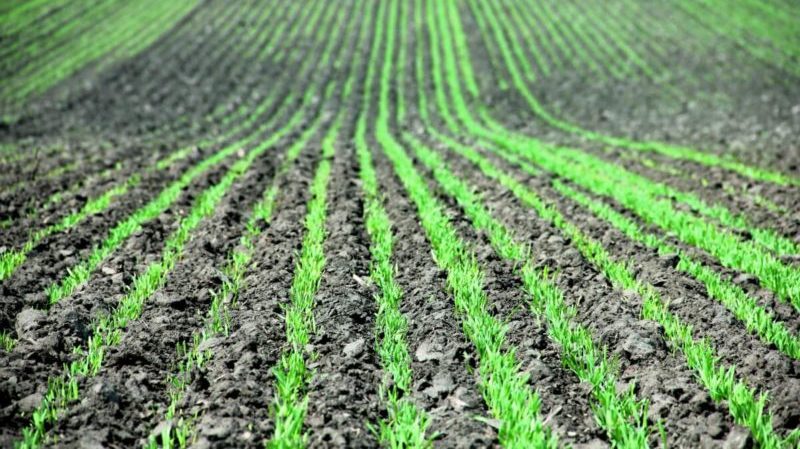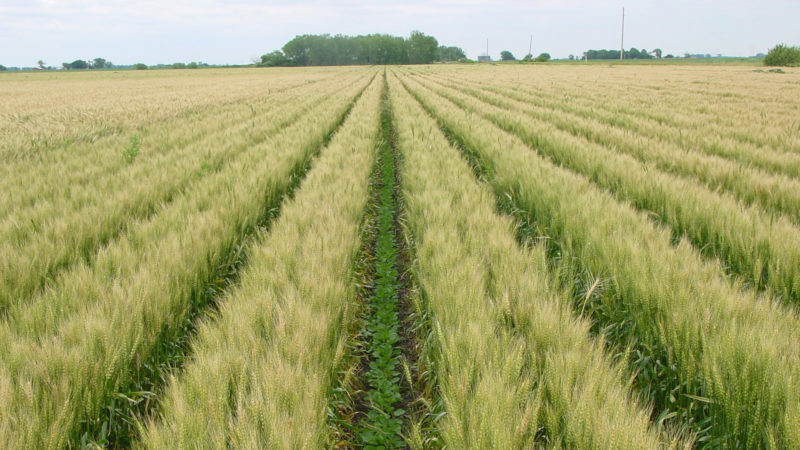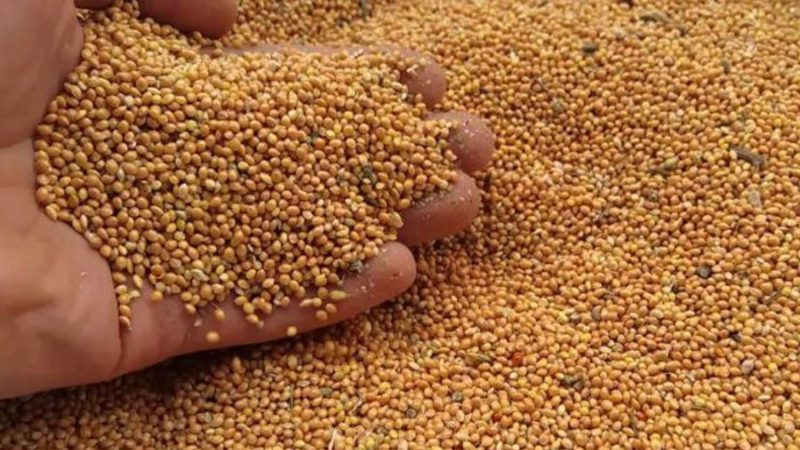Dates and rates of millet sowing with an ordinary sowing method and further care of plantings
Millet is one of the most widespread crops in the world. It is cultivated in Asia, Europe, Africa, America. In terms of the content of nutrients, millet is irreplaceable in human nutrition. It is especially useful for people with diseases of the cardiovascular system, since it contains a large amount of easily digestible potassium.
The agricultural technology of millet allows it to be cultivated in a variety of natural and climatic zones. This crop is drought tolerant, high yielding and low cost. The article will tell you about the technology of cultivation and planting millet seeds in an ordinary way.
The content of the article
What is an ordinary sowing method

Compliance with the technology of cultivation of agricultural crops is a guarantee of a rich harvest. The most important steps include determining the optimal sowing method.
The ordinary method is more often used for cereals, since it provides better conditions for seed germination, allows the grain to receive maximum nutrition from a unit area, uniformly illuminate the plants and not shade each other.
In addition to cereals, this method is adopted for many vegetable and industrial crops.
The main characteristic of a row sowing is the row spacing. It depends on the requirements of the culture for agricultural technology. For example, row crops are planted less often - with a width sufficient for the passage of cultivators. In this way, potatoes, buckwheat, corn, beets, sunflowers and others are planted.
For cereals, including millet, 15 cm is enough. This method is called narrow-row. The sown area is rectangular. On slopes, rows are built crosswise to prevent soil erosion and reduce moisture loss. The seeding step, as a rule, for grain crops is 1.2-1.5 cm. The rows are located from north to south for maximum illumination.
The cross method consists in a double pass of the sowing area: along and across at a reduced seed placement rate. Thus, a better placement of plants in the rows is achieved, which subsequently will allow them to receive sufficient lighting, nutrition and moisture.
The belt row method is that crops are sown in 2-3 lines with wide aisles. This allows plants to develop well and allows them to be processed mechanically.
For the row sowing method, opener or disc seeders are used.
Reference. The first were simply cultivated by the Chinese 7,000 years ago.
other methods

Depending on the sown crop, climatic conditions and soil characteristics, other types of sowing can be used:
| Way | Features: | Culture |
| Solid | The grain is scattered using planes and seeders without openers.
A rarely used method due to large losses of seeds, poor embedding of seeds into the soil. |
Rice, herbs for winter crops, lupine |
| Dotted | Produced by precision planters for even distribution of calibrated seeds. This allows you to replace manual plant breakthrough with mechanical thinning. | Cropland: sugar beet, corn |
| Ridgevoy | The seeds are planted in rows on the tops of the ridges in northern areas with waterlogged soil. | Potatoes, vegetable crops |
| Square | Plants are planted in the corners of the square, which completely eliminates manual labor when leaving. | Seedlings of vegetables (tomatoes, eggplants), melons |
| Gnezdovoy | Seeds are planted in nests of several in each. | Row crop |
| Square-nested | Embedding several seeds in the soil at the corners of the square for faster germination, better growth and fully mechanized weeding. | Potatoes, corn, cotton |
The choice of the sowing method is determined not only by the specified conditions, but also by the agricultural equipment available to the enterprise and economic benefits.
Reference. More than 440 species of millet grow all over the world.
Seeding rate of millet with the row sowing method
Depending on the chosen method of planting seeds in the soil, it is necessary to maintain the correct ratio of the amount of grain per hectare of area:
- in arid or steppe regions with narrow-row sowing - 3 million germinating grains per hectare, with wide-row sowing - 2.5 million;
- in forest-steppe zones by any of the sowing methods - 3.5 million seeds per hectare.
In unfavorable weather conditions, the seeding rate should be increased by 15-20%.
Sowing dates

Depends on varieties (early, mid or late ripening), region, weather conditions, degree of weed infestation in the field.
In the southern, more arid zones, the crop matures even when planted in early July. However, you need to monitor the dryness of the soil - if its top layer is dehydrated, you can no longer sow.
If the timing of the onset of spring coincides with long-term observations, millet can be planted as early as mid-May, starting from the most contaminated fields. Until mid-June - provided that the optimum level of soil moisture is maintained - in areas cleaner from weeds.
Reference. The food uses a grain known to everyone as millet.
Sowing depth
Depending on the degree of soil moisture, millet is sealed:
- to a depth of 4-5 cm with moderately moist;
- 7-8 cm when dry;
- 10 cm on light soils.
Due to the presence of epicotyl, millet tolerates deep planting.
Optimal growing conditions
To obtain friendly fast shoots, it is necessary to take into account the temperature of the soil and air when sowing millet.
Minimum temperature for germination
It is necessary to sow millet only when the threat of frost has passed, and the soil has warmed up to + 12 ... + 15 ° С.
The most intensive seed germination is observed when the air temperature is + 25 ... + 30 ° С. The critical minimum is + 8 ... + 9 ° С. At this temperature, seedlings appear in 10-15 days, at + 15 ° С - after 5 days, at + 20 ... + 25 ° С - after a maximum of three.
If after the emergence of seedlings the temperature drops to -3 ... -5 ° C, the plants will die.
Reference. Millet porridge indispensable in dietary nutrition - it removes toxins from the body and has a positive effect on all systems and organs.
How millet grain grows and blooms
Millet Is a herbaceous annual reaching 1.5 m... Well-developed root system, hollow, branched, cylindrical stems with slight pubescence, lanceolate leaves. A drooping panicle inflorescence can be up to a third of the plant's height.
Spikelets are located at the end of the branches one at a time. Each has two self-pollinating flowers. By the end of the growing season (in different varieties from 60 to 120 days), fruits ripen - rounded caryopses with a diameter of about 2 mm of various colors depending on the variety (from white or yellow to red and even black).
Cultivation technology
Millet is also used as an insurance crop. Due to the late sowing time, they can replace dead seedlings of winter or spring cereals. For almost all crops, millet is the optimal predecessor. It is not recommended to sow it just before or after corn due to the risk of stem moth injury.
Suitable predecessors for millet:
- legumes;

- row crops;
- perennial herbs;
- weed-free winter cereals.
Soil preparation:
- weed removal;
- accumulation and retention of moisture;
- fertilizer.
When applying top dressing to the soil, the following proportions must be observed per 1 centner of grain:
- 3.3 kg - potassium;
- 3.0 kg - nitrogen;
- 1.4 kg - phosphorus;
- 1 kg - calcium.
Nitrogen fertilizers increase the yield of millet, rather than stimulating the growth of powerful green mass, as in most cereals. Organic dressings are applied when growing predecessors to reduce the risk of weed overgrowth.
With a lack of any trace elements in the soil, they are introduced at the stage of emergence. To stimulate good development of the root system at the beginning of the growing season, additional phosphorus is added.
The variety is chosen taking into account the zoning, soil acidity, soil fertility, the timing of grain germination, the amount of precipitation. In the Russian Federation, about 50 varieties of this culture are zoned.
The best ones are:
- Saratov 853 - for the southern and southeastern regions.
- Dolinskoe 86 - for the center and east of the Russian Federation.
- Veselopodolyanskoe 367 - for the central Chernozem region, south and southeast.
- Kazanskoe 506 - for Siberia and the Urals.
- Novourenskoye 241 - for the center and north-east.
- Omsk 9 - for Siberia, Udmurtia and the Nizhny Novgorod region.
- Podolyanskoe 24/273 - for central and black earth regions.
Seed preparation
To disinfect and increase germination, it is necessary to etch the seeds with the preparations "Fenoram", "Vitavax" or "Baytan" two weeks before sowing. Then they are kept for 5-7 days in air with periodic shoveling to increase the germination energy.
Crop care
Care includes post-sowing packing and pre-emergence harrowing, as well as a number of standard procedures:
- Roller and ball rolling for greater seed-to-soil contact in dry areas.
- Harrowing with light tine harrows, mesh harrows or seeding harrows to loosen the soil crust and undermine weeds. This procedure is carried out twice during the growing season - before germination and with bushiness.
- Weed control. Spraying of crops in the tillering phase with herbicides: "Agritox" - 0.9-1.5 l / ha, "Elant" - 0.6-0.8 l / ha, "Magnum" - 8 g / ha.
- Protection from pests. In the phase of sweeping millet against the stalk moth, insecticide treatment is carried out: "Karate Zeon" - 0.2-0.3 l / ha, "Senpai" - 0.2-0.3 l / ha. From aphids and millet gnats: "Rogor-S", "Kemidim", "BI-58" - 0.7-0.9 l / ha each.
- Inter-row treatments as weeds grow.
- Hilling in the booting phase.
- Harvest. Since the grain ripens unevenly, if the harvesting technology is not followed, up to 20-25% of the grain can be lost. Therefore, it must be carried out separately: when more than 75% of millet ripens, mowing is carried out with headers with threshing for 3-5 days. The refined grain is dried and stored with a moisture level of 13-14%. With direct combining, harvesting is carried out at 100% maturation of millet. In this way, additional green mass can be obtained.
If the technology for cultivating millet is not followed, crops may die or lead to economic losses due to a low yield.
Reference. The most productive and high-quality cereal is considered to be with a reddish tint.
Productivity from 1 hectare

Millet is a drought-resistant crop that matures even where other crops are dying. Its yield depends on the variety, cultivation technology, natural and climatic characteristics of the region. Subject to the rules of agricultural technology, millet is capable of producing up to 14-17 c / ha.
The cultivated areas of millet in the Russian Federation in 2018 amounted to 259.8 thousand hectares, having decreased by 54% over 10 years. Most of the area under this crop is occupied in Saratov, Rostov, Orenburg, Volgograd regions. In total, 217.2 thousand tons of grain were harvested, and the yield was 11.6 c / ha.
Conclusion
Despite the significant reduction in acreage for millet, it continues to be one of the leading crops in the Russian Federation. This testifies to the great demand for cereal, its quality characteristics, light compared to other agricultural equipment, high productivity and properties useful to humans.
In addition, millet is an efficient forage crop that, in addition to harvesting grain, provides a powerful green mass with minimal production costs.Subject to the cultivation technology, the economic profitability of this cereal is very high.